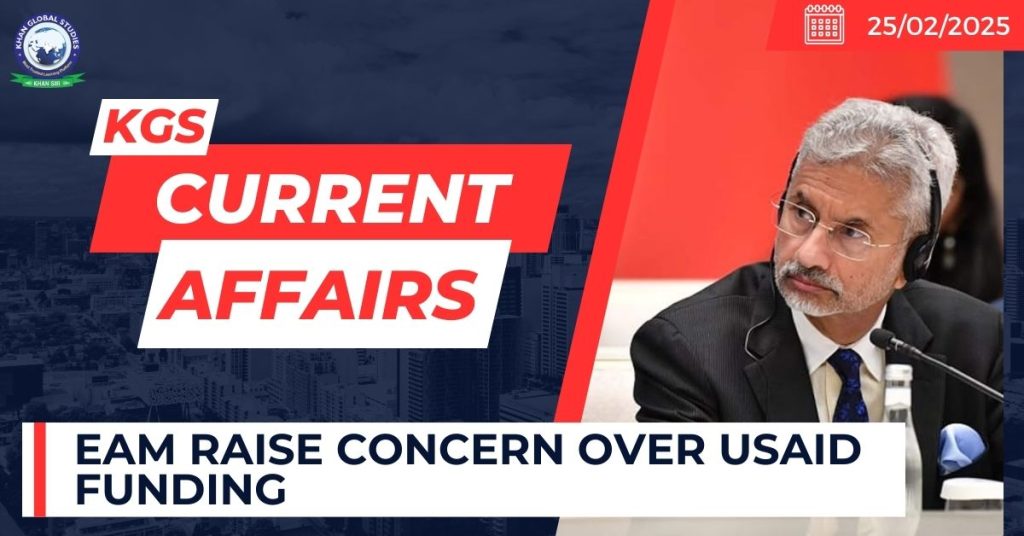Context:
Recently, the Union External Affairs Minister expressed concern over allegations regarding United States Agency for International Development (USAID) funding for ‘voter turnout’ activities.
More on the News
- The USAID controversy gained momentum after Elon Musk-led DOGE (Department of Government Efficiency) claimed it had scrapped a $21 million grant to India which was intended to boost “voter turnout.”
- However, the finance ministry’s latest annual report confirmed that no USAID funding was directed towards enhancing voter turnout in India.
United States Agency for International Development (USAID)
President John F. Kennedy established the U.S. Agency for International Development (USAID) as an independent agency in 1961 a way to counter Soviet influence abroad through foreign assistance.
USAID demonstrates America’s goodwill around the world through
- increases global stability by addressing the root causes of violence
- opens new markets and generates opportunities for trade
- creates innovative solutions for once unsolvable development challenges
- saves lives
- advances democracy, governance, and peace.
In FY2023, USAID provided assistance to approximately 130 countries of which the top 10 are, Ukraine, Ethiopia, Jordan, the Democratic Republic of Congo, Somalia, Yemen, Afghanistan, Nigeria, South Sudan, and Syria.
USAID role in India
- USAID’s engagement with India began in 1951 under the India Emergency Food Aid Act signed by President Harry Truman.
- Union Finance Ministry has revealed in its 2022 report stated that USAID funded seven projects worth $750 million in 2023-24 and brought over $17 billion in economic assistance since inception.
- The Department of Economic Affairs, which oversees bilateral funding arrangements, outlined that these projects focused on agriculture and food security, water, sanitation and hygiene (WASH), renewable energy, disaster management, and health.
- Partnership Agreement for Agri. & Food Security Program: The programs support development innovations that improve the lives of the rural poor in India and work to extend innovations proven in India to other countries.
- Partnership Agreement for Water, Sanitation and Hygiene (WASH): Under it, USAID and the Government of India tested and identified models for safe, affordable drinking water and sanitation services.
- Partnership Agreement for Sustainable Forests and Climate Adaptation Program; Under it, FOREST-PLUS 2.0 (FOREST FOR WATER AND PROSPERITY) (Launched in 2018), was founded to improve the management of targeted forest landscapes in three states in India to enhance ecosystem services and increase economic opportunities
- Partnership Agreement for Renewable Energy Technology Commercialization & Innovation: It focuses on the South Asia region and supports the U.S. government’s Indo-Pacific Energy Initiative: Asia EDGE (Enhancing Development and Growth through Energy).
Partnership Agreement for Health Project: It focuses on various projects like:
- Preventing child and maternal deaths
- Championing a TB-free India
- Controlling HIV/AIDS epidemic
Impact on the world of freezing USAID
1. Humanitarian Crisis
- Disruptions in Essential Aid: Programs focused on food security, clean water, and healthcare in developing nations would suffer, exacerbating poverty and malnutrition.
- Impact on Conflict Zones: Mine clearance efforts, prosthetic aid for war victims, and post-war reconstruction projects could slow down, prolonging human suffering.
2. Foreign Policy Concerns
- Erosion of US Soft Power: USAID has been a key tool for US diplomacy; freezing funds may weaken America’s ability to foster goodwill and influence international policies.
- Undermining Strategic Partnerships: Nations collaborating with the US on development projects might reconsider their alliances, seeking alternative partnerships.
3. Security Implications
- Increased Refugee Crises: Reduced aid in war-torn and disaster-affected areas could force more people to migrate, adding pressure on neighbouring states and global refugee systems.
- Weakened Counterterrorism Efforts: USAID plays a role in countering radicalization through education and economic development—freezing funds could create power vacuums that extremists exploit.
4. Geopolitical Shifts
- Rise of Alternative Powers: The vacuum left by USAID might be filled by countries like China, using aid as a tool for expanding their geopolitical influence.
- China’s Belt and Road Expansion: Reduced US presence in global development could accelerate China’s dominance in infrastructure and economic diplomacy.
Impact on India of freezing USAID
- USAID’s funding may not affect India in a major way. However, it remains to be seen how these existing seven projects, particularly in healthcare fare now, and whether Central or State governments will be able to pick up the tab to keep these projects, and beneficiaries going.
- Healthcare: Although direct financial aid to India has decreased, USAID contributions exceeded USD 50 million in 2024 and its stoppage could impact India’s vaccination programs, infectious disease control, and medical infrastructure.

